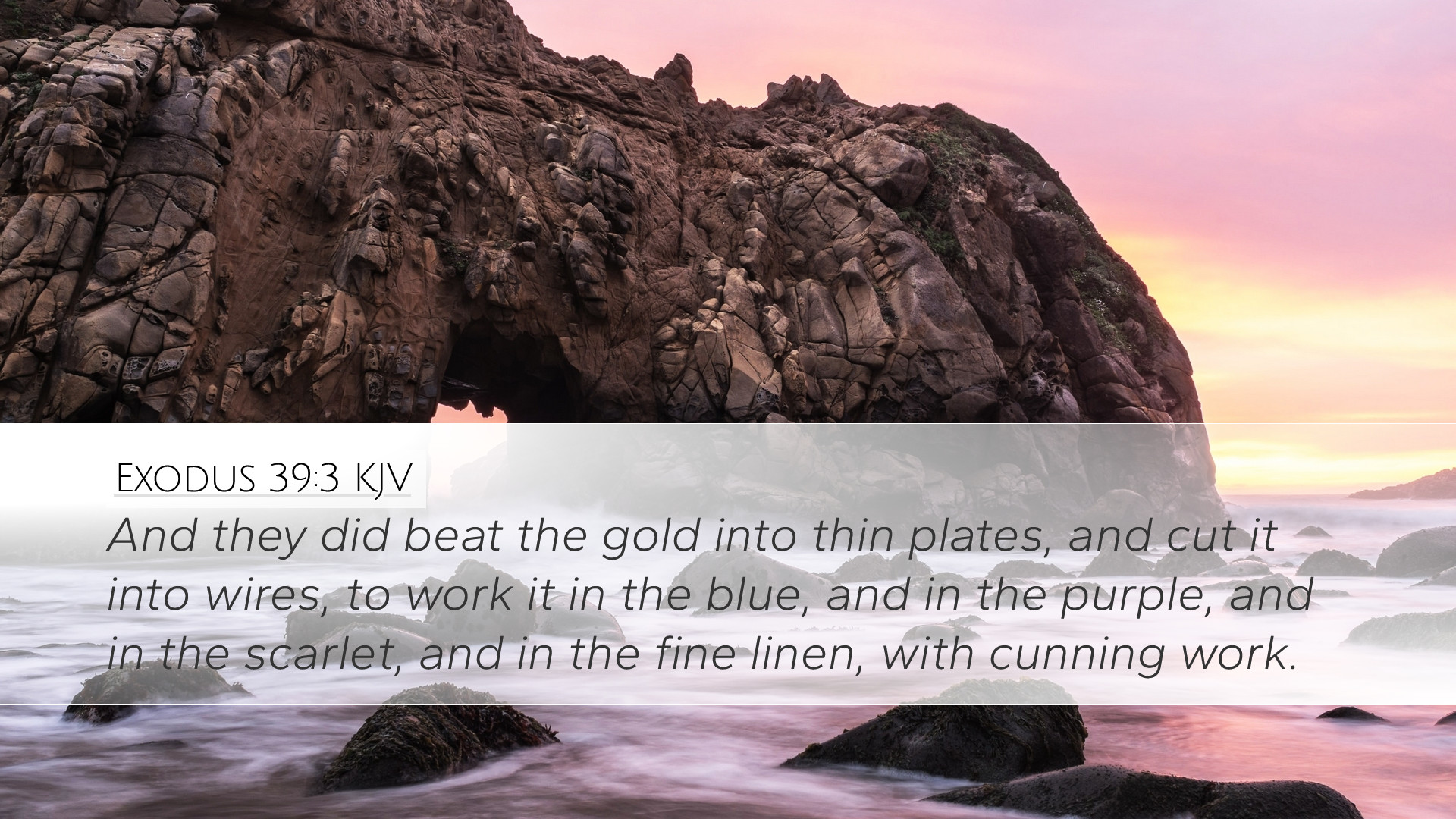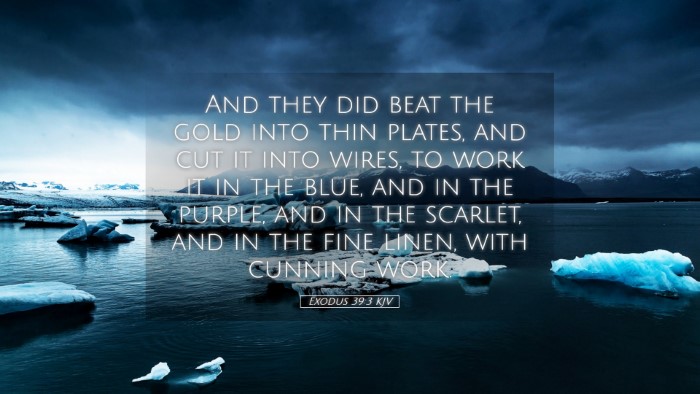Commentary on Exodus 39:3
Exodus 39:3 states, "And they did beat the gold into thin plates, and cut it into wires, to work it in the blue, and in the purple, and in the scarlet, and in the fine linen, with cunning work." This verse details the craftsmanship involved in the construction of the priestly garments, specifically those of the high priest. The meticulous attention to detail in this work reflects both the holiness of the task and the grandeur of God's instructions.
Overview of the Context
This verse is part of the broader narrative concerning the Tabernacle and its furnishings, showing how God’s presence was going to dwell among His people. In Exodus 39, the focus is on the specific preparations made for the priests and the elaborate garments they were to wear when ministering before the Lord. These garments symbolized sanctity, representing the spiritual and physical separation from the ordinary life.
Insights from Commentaries
Matthew Henry's Commentary
Matthew Henry emphasizes the care and precision with which the Israelites carried out God's instructions. He observes that their work illustrates an essential principle of service to God: it must be performed with skill and dedication. Henry notes that the gold beaten into thin plates indicates not only the value of the materials involved but also the labor invested in preparing them. It serves as a metaphor for spiritual life; just as great effort is required to create something beautiful in the physical realm, so too is significant effort essential for cultivating a vibrant spiritual life.
Albert Barnes' Notes
Albert Barnes draws attention to the materials mentioned in the verse, particularly the blue, purple, scarlet, and fine linen. He posits that these colors were significant in the ancient context and symbolized royalty, wealth, and purity. The gold signifies divinity, indicating that the priesthood's work is intimately connected with God's holiness. Barnes goes further to analyze the specific references to "cunning work," suggesting that this reflects the wisdom and skill given by God to those who executed these designs. It underscores the notion that dedicated service to God requires both ability and artistry.
Adam Clarke's Commentary
Adam Clarke provides a detailed observation on the use of fine linen and the types of threads used in the garments. He highlights that the intricate weaving techniques represent the unity and diversity within the body of Christ today. The blending of various colors and materials symbolizes the diversity of gifts in the church, all working together to produce a beautiful tapestry of worship and service that glorifies God. Clarke also notes that this level of craftsmanship points to the care with which we should approach our commitments to God in service and in life.
Theological Implications
The construction of the priestly garments as described in Exodus 39:3 is critical for understanding the nature of God’s covenant with His people. Here are some theological implications:
- Holiness and Service: The extreme care exercised in crafting garments for the priests underscores God’s call to holiness. Just as these garments were made with precision and intent, believers are called to live lives that reflect God's holiness.
- Representation of Christ: The high priest’s garments foreshadow the ultimate high priest, Jesus Christ. The intricate details and the materials reflect His deity and the majestic nature of His work.
- Community of Believers: The collaboration shown in the work signifies the community's role in building the body of Christ. Every believer contributes their unique gifts, much like the various materials and skills combined in the priestly garments.
Application for Today
As we reflect on Exodus 39:3, several applications emerge:
- Commitment to Excellence: Believers are encouraged to pursue excellence in their ministry and service, honoring God with the gifts and resources He has entrusted to them.
- Understanding of Spiritual Identity: Just as the priests were set apart in their garments, Christians today are called to understand their identity in Christ and live accordingly.
- Search for Unity: The diverse colors and materials remind the church of its need for unity among diversity, working together harmoniously for the Kingdom of God.
Conclusion
Exodus 39:3 serves as a poignant reminder of the sacredness of service to God. The careful craftsmanship of the garments illustrates a deep respect for God’s instructions, and it challenges believers to embrace their roles in the service of Christ with the same dedication and skill. As we study this verse, may we grow in our understanding of the interplay between divine holiness and human craftsmanship, reflecting God's beauty and goodness in all we do.


